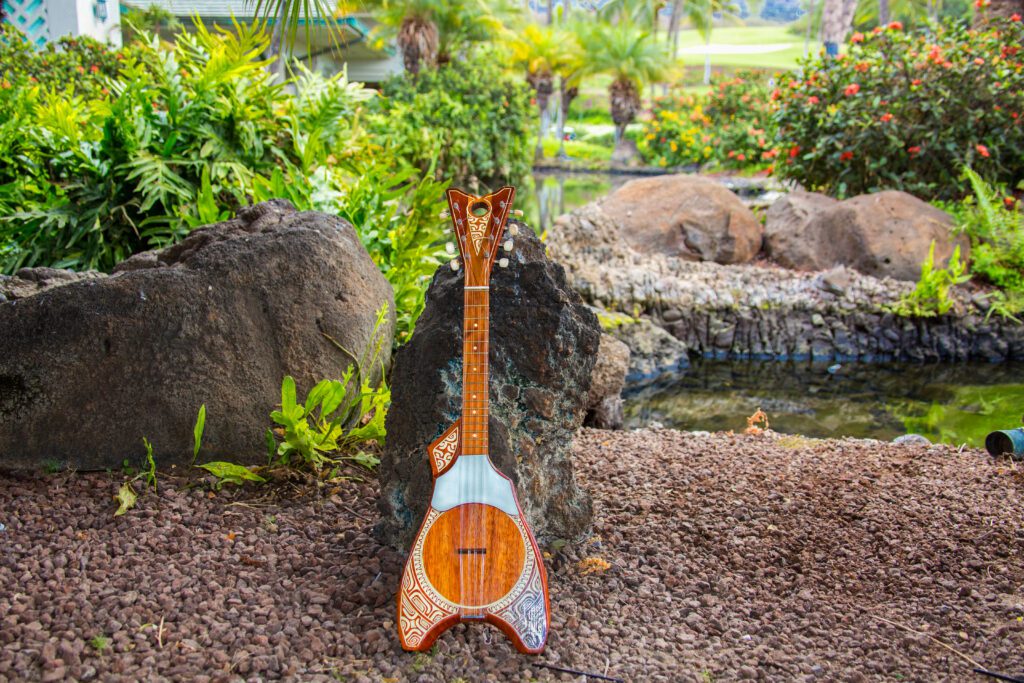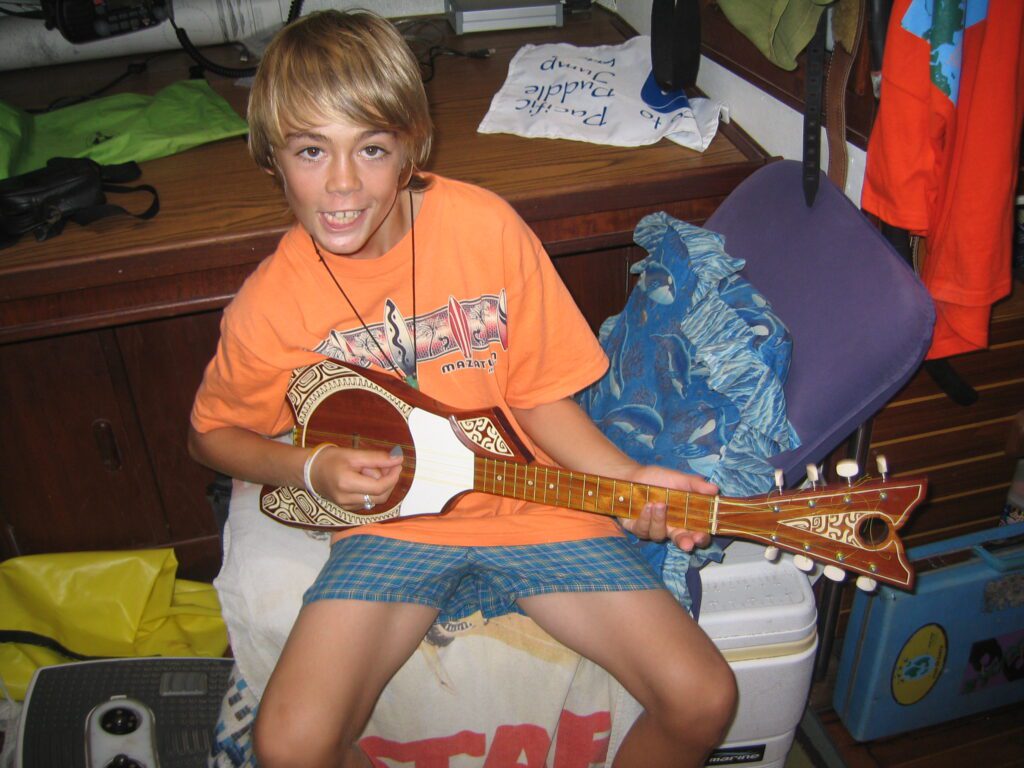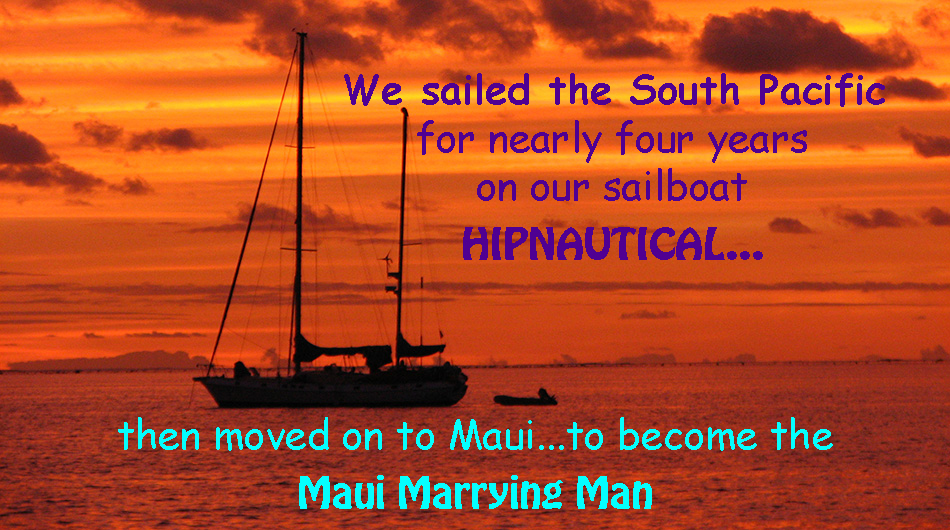
The Ukulele has long been considered as Hawaii’s national instrument,
lending itself to be synonymous for an ‘Island Style’ sound.

The first rendition of this instrument has its origins in early European and Middle Eastern plucked stringed instrument in the lute spin-offs. In the Portuguese Islands of Madeira, the Machete was developed and became a popular local music style that eventually took the world by storm.

First introduced in Hawaii in 1879 when the ship Ravenscrag docked in Honolulu with immigrants to work in the sugar cane fields, a band of Portuguese musicians hopped off the boat and began playing this lovely ‘new to Hawaii’ instrument. The Hawaiians saw Joao Fernandes playing so fast it looked like his fingers were “jumping fleas” which roughly translates to ‘ukulele’. Also aboard were three talented cabinetmakers-Augusto Dias (1842-1915), Manuel Nunes (1843-1922), and Jose do Espirito Santo (1850-1905), as luck would have it, they didn’t need to work the sugar fields or make cabinets, as a growing local interest in this small guitar-like instrument, Dias, Nunes, and Santo all opened their own instrument shops in Honolulu by 1886.

Edward Purvis, an Englishman played the ukulele and acted as an Assistant Chamberlain to King David Kalakaua, the last reigning King of Hawaii, an accomplished musician and composer who became an avid ukulele player. Purvis had been nicknamed ‘Ukulele’ (jumping fleas) on account of his short stature and energetic personality, eventually it is thought that through his popularity with performing for the King, this instrument began to be commonly known as the Ukulele. Ether way, it’s all about jumping fleas.

No place on Earth can match Hawaii’s lure and beauty… Except for the fabled Islands of the South Pacific and particularly the Marquesas Islands. Unlike Hawaii, this island group was not along a strong trade route, they did not import massive immigrants to work sugar fields and did not have large cattle ranches that required the expertise of Spanish cowboys or as the Hawaiian cowboy – Paniolo, a sort of slang word of español, the language the vaquero cowboys spoke. As the popularity of Hawaii’s Ukulele reached these far and remote islands, there was no Spanish Luthiers to build these little guitar like instruments, eventually the local island craftsmen began to construct a true island version of their own. As America’s Hawaiian island fantasies became known as ‘Hawaiiana’, an ‘Americana’ influenced style of Hawaiian music became very popular with heaps of ukuleles being produced all over America ranging from cheap ‘Hawaiian-like’ ukulele toys to very high quality instruments that further raised the bar of excellence and pride; one was un-desirable, the other was un-affordable and both were not part of the trade routes to the south pacific and thus un-available.
Although the true Hawaiian ukulele made with local Hawaiian Koa wood is a masterpiece of luthiership, it still closely resembles a little spanish guitar, and that is nothing short of a huge compliment as to this day the best clasical guitars are still built by Spanish luthiers; however the amazing Marquisian Banjo is a one of a kind design that is typically hand built maticuously with pride with a ‘hodge-podge’ selection of componets like the tuners, which often came from other broken stringed instruments in the early days. The technical wood working skills using thinly cut wood laminates, bending them to the curvy shape required for creating a nice boomy soundbox were way beyond the tools and material availability on these very far and remote islands. But a clever use of one solid piece of wood in which the neck was shaped, frets tapped in and from the back, a small sound hole was created and from which the insides were hollowed out dexterously leaving a thin sound board that astonishingly re-creates the poppy percussive sound of a banjo. The basic shape was just a starting point, each Marquesan Banjo was often hand crafted by the musician to fulfill a useful connection to their instrument and hand painted using the traditional tappa print patterns unique to their family, clan and village, a lineage carried on for two millennia.
To this day, for the most part, the Marquesas is still off the beaten path of main stream tourist and seem to live quite well without our monstrous mammoth megga Malls. But then getting almost everything is very pricey with costly shipping rates and import duties, so often if you want a really nice fretted string instrument, you would be inspired to build one yourself.

During our Sailing Adventures, we enjoyed a stay in Fata Hiva while anchored in the Bay of Virgins. One of the most idyllic tropical island dream places that we experienced with it’s eroding volcanic cauldron walls forming very distinct ‘phallic’ hard as stone natural erections of natural grandi tute. The bay was of course apply name with something roughly translated to ‘Bay of Boners’. Nothing could prepare the first missionaries for such a shock as this, not even the many gruesome cannibal rituals withinsessed as just another new world view to understand, but… Imagine writing the expected progress report for the pope which would end with:
“your obedient servant in god’s pure name. Father Heathen Saver at the holy encampment embedded in the Bay of Bonners. “
The name of the bay was changed before the first progress report was ever sent I’m sure.
The churches are still a prominent feature to each village despite the archaic belief system that predates even their primitive beginnings in these islands, but a Spiritual comfort binds the souls that fills a social and personal need. With an even more outward passion, a strong sense of traditional bridge building is continuing to take place as each village honors the time honored traditions of passing on their history in the age old verbal traditions and incorporating their story in songs and dance which are ritually performed and even compete or honorarily represent their village in Trans-Polynesian wide events.
It seemed like just about every family in the village was ether in the dance or had a loved one in the event. The Warrior men portrayed their brave forefathers that conquered this primitive and rugged area, their mighty physical stature must have been very intimidating to the first ‘Papalangi’ white explorers. In hand to hand combat the brute force of a Marquasian warrior was unbeatable. The ground shook beneath their bare feet as they lunged deathly with their spears and shields, while the beautiful ‘Wahine’ woman seductively swished and thrust their curvy hips to the traditional sounds of their Polynesian roots. The ‘Band’ was a colorful group of local musicians with an impressive collection of hand made drums huewn out of big local trees found way up in the hills. One fellow in particular played a hand made Marquisian Banjo, his talent stood out from the rest; he also played a 6 string acoustic guitar.


Later we took up a ‘conversation’ with this fellow that didn’t really speak English, and we didn’t really speak much Marquesan but we both knew enough French to figure out that he would love to trade his meticulously hand carved Marquesan Banjo for my son’s Gibson Les Paul Jr. electric guitar. We included a battery powered amp and we were all ecstatic, the next day our new friend could be seen rocking out all throughout his village. This Marquesan banjo looks like a Polynesian version of the ‘holy grail’ of classic rock guitars… The Gibson Flying V, but with 8 strings!
We had sailed over 10,000 miles before our Marquesan experiences and we have respectfully maintained this instrument through over 10,000 sailing miles that followed. Bobbie Jo got to know this instrument as we sailed throughout the South Pacific and brings that
Tropical Island Spirit to the ‘Soul of Aloha’.
We repaired the original whale bone neck nut with a whale bone replacement from a Hawaiian ukulele luthier and this truly original South Pacific Island ‘ukulele’ continues to perform
lively island style wedding music.
If you will be having a Destination Wedding consider coming to Maui, our Tropical Island Beach Weddings are great all year long. Contact Roger the Maui Marrying Man for all your Maui Destination Wedding Planning Wishes.
A ‘Tried and True’ locally based Mom and Pop – One Stop Shop!
roger@mauimarryingman.com


Bobbie Jo and this article’s author Roger Curley have a deep connection to the ocean and the Tropical Islands they have sailed to and lived among during their 4 years of Sailing Adventures with their son Robin aboard their ‘ol 51 foot sailboat ‘Hipnautical.’
We Bring the “Spirit of the South Pacific with the Soul of Aloha” –
Joining loving couples in the deepest expression of Love!
Prior to our Sailing Adventures I enjoyed the experience of a 30+ year career in Hollywood’s Film, TV and Audiophile recording industry while Bobbie Jo has been performing Harp and Vocals at Wedding Ceremonies for over 30 years as well;
she then picked up the Ukulele and Marquesan Banjo on our Sailing Adventures.
We bring our highly technical photography, video and worldly experiences together for Simply Elegant Dream Weddings on a Tropical Island.
See a video of the famous Hawaiian Wedding Song played on a Marquesan Banjo.
Just scroll down and click the title – the famous Hawaiian Wedding Song played on a Marquesan Banjo




